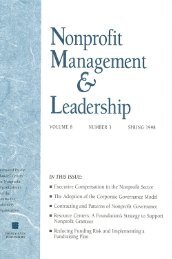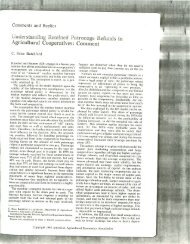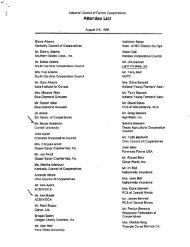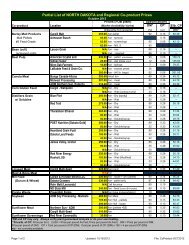Sunflower Production Field Guide - Your "Home Page"
Sunflower Production Field Guide - Your "Home Page"
Sunflower Production Field Guide - Your "Home Page"
Create successful ePaper yourself
Turn your PDF publications into a flip-book with our unique Google optimized e-Paper software.
32<br />
■ Cutworms<br />
Species:<br />
Darksided cutworm Euxoa messoria (Harris)<br />
Redbacked cutworm Euxoa ochrogaster (Guenee)<br />
Dingy cutworm Feltia jaculifera (Walker)<br />
Description: Darksided cutworm — Forewings<br />
of the adult darksided cutworm are usually light,<br />
powdery and grayish brown with indistinct markings<br />
(Figure 22). The larvae are pale brown dorsally and<br />
white on the ventral areas (Figure 23 ). Sides have numerous<br />
indistinct stripes. At maturity, they are about<br />
1.25 to 1.5 inches (32 to 38 mm) long and 0.19 inch (5<br />
mm) wide.<br />
Redbacked cutworm — The forewings of the adult<br />
redbacked cutworm are reddish brown with characteristic<br />
bean-shaped markings (Figure 24). The larvae are<br />
dull gray to brown with soft, fl eshy bodies and may be<br />
1 to 1.25 inches (25 to 32 mm) long when fully grown<br />
(Figure 25). Larvae can be distinguished by two dull<br />
reddish stripes along the back.<br />
Dingy cutworm — Forewings are dark brown with<br />
bean-shaped markings as in the redbacked cutworm<br />
adults (Figure 26). Hind wings in the male are whitish<br />
with a broad, dark border on the outer margin; in the<br />
female they are uniform dark gray. The larvae have<br />
a dull, dingy, brown body mottled with cream color.<br />
The dorsal area is pale with traces of oblique shading<br />
(Figure 27).<br />
Life Cycles: The female darksided and redbacked cutworm<br />
moths deposit eggs in the soil in late July and<br />
early August. The eggs remain dormant until the onset<br />
of warm weather the following spring. The larvae of<br />
both species emerge from late May to early June. They<br />
continue to feed and grow until about the end of June,<br />
when fully grown larvae pupate in earthen cells near<br />
the soil surface. The pupal period lasts about three<br />
weeks. Both species have one generation per year.<br />
The adult dingy cutworms emerge in August and are<br />
active until mid-October, with peak activity in September.<br />
Eggs are deposited in plants in the Compositae<br />
family in the fall. The larvae develop to the second<br />
or third instar in the fall and overwinter in the soil.<br />
Pupation occurs in the spring to early summer. One<br />
generation of this species is produced per year.<br />
■ Figure 22. Adult - Darksided cutworm<br />
Euxoa messoria. (Extension Entomology)<br />
■ Figure 23. Larva - Darksided cutworm<br />
Euxoa messoria. (Extension Entomology)<br />
■ Figure 24. Adult - Redbacked cutworm<br />
Euxoa ochrogaster. (Extension Entomology)<br />
■ Figure 25. Larva - Redbacked cutworm<br />
Euxoa ochrogaster. (Extension Entomology)







